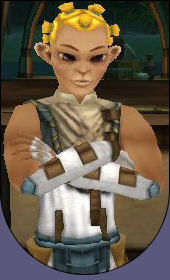
Interview A Tryker Wedding Story Today we present an interview with Satty Ribben, an old Tryker Dame who has officiated at several generations of Tryker weddings. Satty is here to give us an oversight of how such ceremonies are preformed. Oh no, not at all, our weddings don’t work in that way. I am rather what you would call the Mistress of Ceremonies. The master or mistress of ceremonies does not need to be a fully trained priest or priestess. All that is needed is to be familiar with the wedding ritual and happy to conduct the ceremony in our tightly-knit community. Of course, there is also the proviso that they have been happily married for at least three years, so reflecting our Tryker principle of practicing what you preach! Well the first thing is it does not happen for three months. To avoid any future problems we have a tradition that before taking the plunge couples must first respect a period of engagement lasting three months. During this time the couple lives together and sees how they get on together. Only at the end of this engagement period may friends and relations officially speak about the place and date of the wedding. Nevertheless, traditionally the wedding ceremony takes place on a Holeth (the day of Jena) on the fourteenth week of the engagement period.
Traditional Tryker weddings can last for days and involve much gaiety and merry making. Tryker marriage customs generally reflect the cooperative and brotherly spirit of the community, and are full of laughter and song and not a few jokes and tricks.
According to our ancient Tryker tradition, the bride and groom are honoured by anyone’s presence at their wedding as it means that they care about the couple. Therefore anyone who cares may attend the wedding!
Traditionally guests give money, the amount of which should be of multiples of two. However, it is becoming more and more fashionable among young Trykers to give finely crafted objects instead. Of course, food and drink also play an important part in the celebrations!
Tryker weddings usually take place outside on a beach, under a canopy, if possible. Homins sit on the ground or on mats behind the sacred fire which symbolizes the consummation of time and the warmth and comfort it can bring. The groom’s party arrives first at the wedding spot followed by the bride's party Yes they are an important symbol of the eternity of love. Rings which can be crafter by the couple or their witnesses are always exchanged by bride and groom, and traditionally the groom presents the bride’s mother with a small token as does the bride to his mother.
Yes the bride is supported by her parents or close friends, and she will need two witnesses, one of each sex. The groom has the same requirements. In addition there are bridesmaids, and a chorus of tuneful Trykers to sing the old well-loved melodies.
Dress is generally colourful, black is to be avoided. A wedding is a time to flaunt your best jewels. Of course, liberties can be taken regarding the dress. One rule which shouldn't be broken, though, is that anyone who enters the wedding area must remove their shoes or boots. Both bride and groom customarily use pigment to decorate their faces. This tattoo symbolizes devotion. It is said that you can tell how well a new bride and groom are being treated from how long it takes for the dye to wear off! « Back |

|
|
|



